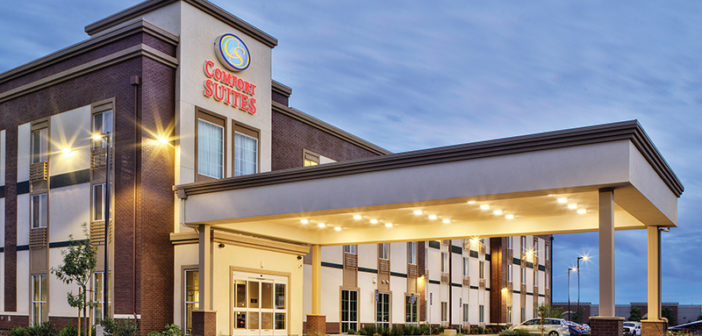ROCKVILLE, MD—It’s no secret brands, developers and guests are all giving the upper-midscale segment attention. Aware of this undeniable embrace from all directions, Choice Hotels International Inc. is continuing its promise to highlight the Comfort brand’s efforts to build a hotel portfolio encompassing key strategic markets.
“The Comfort brand is growing rapidly,” said Brian Quinn, VP of franchise development at Choice. “We’re continuing to focus on making sure all current Comfort hotels meet and exceed guest expectations, as well as building new hotels in the right markets. The new properties are great examples of the brand’s strategic transformation, which was informed by our guests and franchisee feedback, and features a refreshed, modern look and feel. Comfort hotel prototypes are cost-effective to build, maintain and operate, which contributes to a strong return on investment for franchisees.”
Early last month, Choice, in an effort to further spotlight brand transformation and showcase new design initiatives, unveiled its growth plans for the Comfort hotel brand this year—56 new properties across the country, which is, essentially, a new hotel each week.
“The Comfort brand is currently experiencing its strongest pipeline in history,” said Anne Smith, VP of brand strategy for the hospitality group. “We are on track to meet or exceed 56 new openings this year. The team is dedicated to working with the franchisees to grow the brand, not only in number, but in strategic locations, too.”
Key regions of expansion for the hotel company in 2017 include Salt Lake City; Dallas-Fort Worth, TX; Charleston, SC; Jacksonville, FL; North Myrtle Beach, SC; Austin, TX; Oklahoma City; and Tampa, FL. Last month, the hospitality group reported the openings of six Comfort locations across the country—including a mix of new-construction and conversion projects: Comfort Suites in Johnston, CO (92 guestrooms); Comfort Suites in Brookings, SD (100 guestrooms); Comfort Inn & Suites in Kew Gardens, NY (85 guestrooms); Comfort Inn in La Porte, IN (64 guestrooms); Comfort Inn in North Aurora, IL (84 guestrooms); and Comfort Inn in Dallas (103 guestrooms).
“The Comfort brand’s transformative success is a result of bold innovation,” Smith said. “It’s paying off as Comfort is beating the upper-midscale segment in RevPAR growth and stealing share, all while securing all-time high guest satisfaction scores. In Q1 of 2017, 25 new Comfort franchise agreements have been signed, including markets like New York, Philadelphia and Memphis, TN. We’ll continue to focus on aggressively growing our pipeline this year and opening a hotel a week in popular travel destinations.”
The brand last month noted 27 consecutive months of RevPAR Index gains—touting its movement in the upper-midscale segment with respect to this growth. Nearly 67% of the 121 executed agreements for new Comfort locations in 2016 were new-construction projects (according to Comfort, this number has tripled in the last eight years).
Pointing to available data published by STR, Robert Mandelbaum, director of research information services at CBRE Hotels’ Americas Research, told Hotel Business that the upper-midscale segment in 2016 “made up 17.9% of the available room count, 18.5% of the accommodated room nights, and 16.65% of the total rooms revenue in the United States.” And, he said, according to STR’s pipeline report for April, “the top four brands with the greatest number of rooms under contract for development are all upper-midscale brands. In aggregate, the four brands represent 27.3% of all rooms under development in the U.S.”
The reason why developers are gravitating toward upper-midscale brands is a simple one: Consumers like them. “Per STR, the first quarter 2017 occupancy for the segment was 67.5%,” reported Mark Woodworth, senior managing director of CBRE Hotels’ Americas Research.
“The development economics (construction costs, etc.) relative to the demonstrated profit potential yields an attractive investment story,” Woodworth continued. Citing the “2017 CBRE Trends in the Hotel Industry” report, he said the gross operating profit margin in 2016 for limited-service hotels was 44.6%. “According to the current STR census, the average upper-midscale hotel contains 98 guestrooms. Thus, they are comparatively small and take less time to develop,” he said. “This reduces the development risk.”
To sum it up, Mandelbaum explained: “In general, the more popular brands have created a product that both developers (and their lenders) and consumers like.”
Lodging Econometrics (LE) recently reported that the upper-midscale segment is currently at 2,067 projects (205,662 rooms); it has the largest project count of any chain scale segment in the total pipeline. The same analysts pointed out that the largest number of projects in the upper-midscale pipeline include the following brands: IHG’s Holiday Inn Express with 412 projects (38,160 rooms); Hilton’s Home2 Suites with 344 projects (36,074 rooms); and Marriott International’s Fairfield Inn & Suites with 285 projects (27,220 rooms).
But, as far as momentum, the same report acknowledges Choice’s new project announcements by rooms into the pipeline in Q1. Under LE’s evaluation of this category, Choice falls second in the top three with 117 projects (8,118 rooms)—right between Hilton with 162 projects (18,387 rooms) and Marriott with 55 projects (7,129 rooms).
Choice designed the Comfort brand prototype to “work in a variety of markets with its superior offerings and service for both business and leisure travelers,” Smith explained, noting the brand’s ongoing efforts to expand in primary, secondary and tertiary markets, which are “based on guest and developer feedback, weighing the impact and opportunity for the owner through every step. It’s our goal to be everywhere leisure and business travelers are and everywhere they need to be. And, with more than 1,800 Comforts across North America, we’re on our way.”
“Building on the strong momentum of 2017, the Comfort brand is optimistic we’ll exceed our openings goal in 2018,” Quinn emphasized. “We’ll continue to focus on our growth strategy, building new-construction as well as taking on adaptive-reuse and conversion projects in popular leisure and business travel markets. As our strategy continues, we still have substantial development opportunity in the top markets across the country.” HB


